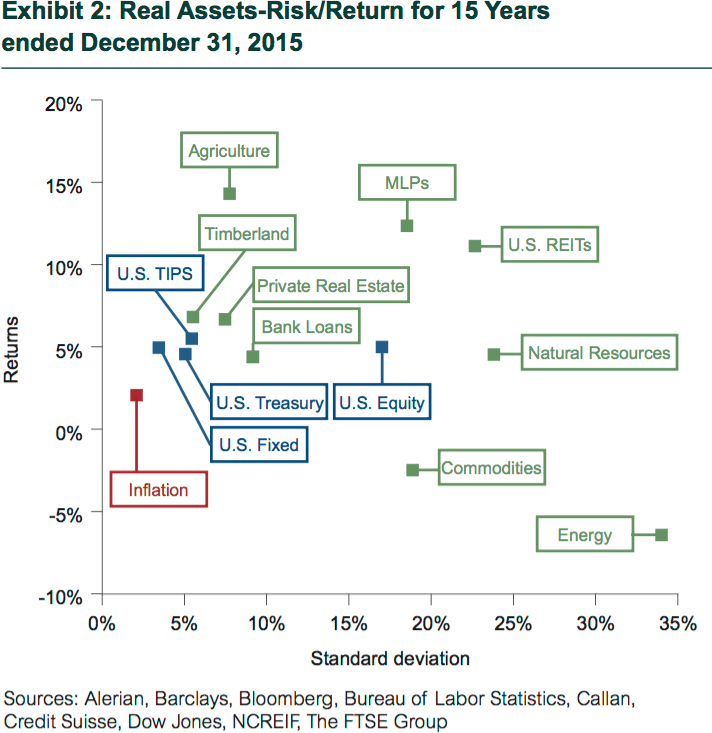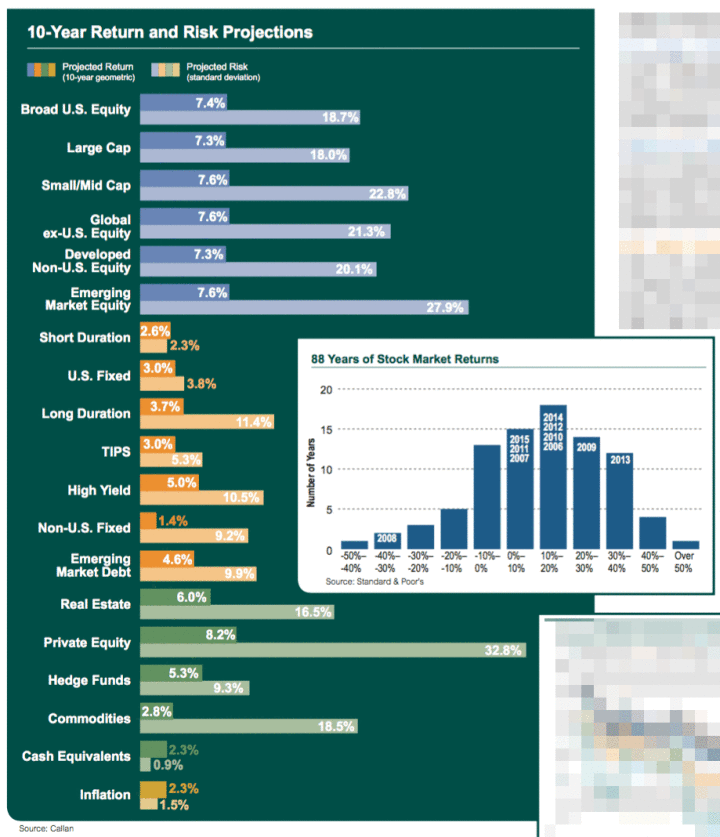Another source of investment research and market commentary that I track is from Callan Associates. You may recall the name from their annual Callan Periodic Table of Returns. In addition to that, Callan offers free access to their entire Research Library with your e-mail address. Their focus is on institutional investors, but there are often things of interest for motivated individual investors. Some of my highlights from their 1st Quarter 2016 papers:
A discussion of investing in “real” assets such as real estate, TIPS, and commodities. As they point out, the best time to consider an inflation hedge is when the risk is considered low. Here a chart of 15-year historical returns vs. volatility for various asset classes.

I would note that it can be very difficult (if not impossible) for an individual investor to get low-cost, diversified, direct access to certain asset classes like timberland and farmland. There are some ETFs being marketed, but they do not provide pure exposure. If you have many millions if not billions, not a problem.
10-year capital market projections. Each year, they share 10-year projected returns for major asset classes. They also go out on a limb and make predictions about expected standard deviation and correlations, which I think is rather bold (and thus I shall ignore it). Below is a partial snapshot (click to enlarge). Download their full report for the test.
Returns are nominal, and their inflation projection is 2.3%. If you are looking for a more optimistic outlook, Callan’s projections are overall higher than many others I have seen. If the predictions of +7.4% annualized returns for US Stocks, +7.6% for International Stocks, and +3% for US Bonds all hold, I will be a happy camper.

 The Best Credit Card Bonus Offers – March 2024
The Best Credit Card Bonus Offers – March 2024 Big List of Free Stocks from Brokerage Apps
Big List of Free Stocks from Brokerage Apps Best Interest Rates on Cash - March 2024
Best Interest Rates on Cash - March 2024 Free Credit Scores x 3 + Free Credit Monitoring
Free Credit Scores x 3 + Free Credit Monitoring Best No Fee 0% APR Balance Transfer Offers
Best No Fee 0% APR Balance Transfer Offers Little-Known Cellular Data Plans That Can Save Big Money
Little-Known Cellular Data Plans That Can Save Big Money How To Haggle Your Cable or Direct TV Bill
How To Haggle Your Cable or Direct TV Bill Big List of Free Consumer Data Reports (Credit, Rent, Work)
Big List of Free Consumer Data Reports (Credit, Rent, Work)
Some of the top performing endowments are allocating 20-25% into Real Assets across listed and unlisted assets. Interesting chart. Individual investors can access timber and farmland through the various REITs that are available as well as actively managed mutual funds that offer diversified exposure to these types of asset classes.Real assets can fulfill different investment objectives, but not all real assets are created equal. Advisors must determine what objectives are most important and construct the portfolio with this hierarchy in mind. Some objectives cannot be achieved simultaneously. For example, if one wanted to achieve short-term inflation protection while maximizing long-term return potential, one of these objectives would need to be compromised to achieve the other.
In evaluating the primary objectives (inflation hedging, portfolio diversification or risk reduction, and return) financial advisors must determine the tradeoffs between the various objectives, because distinct real assets are desired for different objectives. For example, if the advisor is trying to incorporate short-term inflation hedging, commodities and Treasury inflation-protected securities (TIPS) may be utilized. Conversely, an investor would not use these instruments if the objective is to generate long-term inflation protection, or if there is a focus on maximizing long-term return potential.
A wide range of tools (roughly 1,500 real asset securities) within the listed real asset spectrum may help achieve various objectives. In the private markets, investors may wish to invest in private equity-type funds that have closed-end structures, open-end structures, as well as direct real asset investments, all of which require a specific skill set to source, analyze, and transact in the private markets space. Specialist real asset private fund managers are emerging is this space and there is one of the fastest-growing fields in private markets.
Within this wide range, however, comes the fact that “one size does not fit all.” If we examine the real asset allocation of most individual investors, we see small allocations, in the neighborhood of 5–10 percent. Examining the current low-yield environment for the next 5–10 years, and investors focus on minimizing equity risk in their portfolios, advisors are recommending real asset allocations increasing toward the 15–25 percent level and we have seen the trend toward emulating the endowment model where allocations are between 20–25 percent (e.g., Harvard, Yale, Princeton, Stanford).
Investors should never confuse liquidity with safety and should view publicly traded real assets and private markets real assets as unique portfolio components that when combined provide inflation protection, volatility reduction, and return potential.
Forward thinking investors are allocating 10-15% of their overall portfolio to Real assets in a tactical asset allocation approach (percentage allocations may vary predicated upon investors’ needs).
As we have seen in 2016, the publicly traded real asset markets can be some of the most volatile market segments, but volatility can be viewed as an opportunity if managed appropriately. Calculated investment decisions combined with proper portfolio risk management may provide an opportunity to capture some of recent value opportunities created in master limited partnerships, commodities, and real estate investment trusts. Numerous investors are seeing 2016 as the opportune time to start building their publicly traded real asset allocations to help cope with current volatility, uncertainty, complexity, and ambiguity.